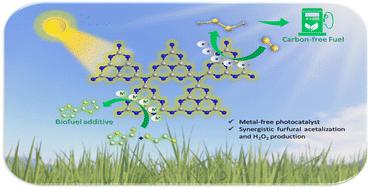当前位置:
X-MOL 学术
›
J. Mater. Chem. A
›
论文详情
Our official English website, www.x-mol.net, welcomes your
feedback! (Note: you will need to create a separate account there.)
Unveiling the solar-driven synergistic production of a cyclic fuel-additive and carbon-free solar fuel from biogenic furfural: mediated by a metal-free organic semiconductor
Journal of Materials Chemistry A ( IF 10.7 ) Pub Date : 2024-11-06 , DOI: 10.1039/d4ta03730h Shivali Dhingra, Arpna Jaryal, Deepak Kumar Chauhan, Kamalakannan Kailasam
Journal of Materials Chemistry A ( IF 10.7 ) Pub Date : 2024-11-06 , DOI: 10.1039/d4ta03730h Shivali Dhingra, Arpna Jaryal, Deepak Kumar Chauhan, Kamalakannan Kailasam

|
Photocatalytic biomass upgradation to fine chemicals and fuels offers a promising strategy to address the current energy crisis and presents a prominent step towards carbon neutrality. Despite several reports in recent years, biomass valorization is still facing a lot of challenges including poor selectivity and inefficient conversion. Notably, photooxidation of biomass results in inefficient utilization of charge carriers which hampers the overall efficiency of the photocatalytic process. In the ongoing quest for effective biomass upgradation, here, we present a metal-free urea-derived carbon-nitride for the photocatalytic acetalization of furfural (Ffal) with ethylene glycol (EG) to generate a cyclic acetal i.e. 2-furyl-1,3-dioxolane (FD), a promising bio-fuel additive integrated with H2O2 production under visible light for the first time. Importantly, an 85% cyclic acetal yield is achieved in 6 h with 99% selectivity along with 162 µmol g−1 of H2O2 production. Under natural sunlight, an exceptionally high yield of FD has been achieved, reaching 70% yield, presenting the practicality of the UCN photocatalyst for the large-scale production of cyclic acetals. In situ EPR analysis, photoluminescence spectroscopy, and photo-electrochemical studies along with various control experiments elucidated the charge transfer mechanism involved in the photoredox process. Thus, the current study offers an encouraging approach for harnessing a metal-free photocatalyst to generate solar fuel coupled with biomass upgradation to fuel additives, thereby presenting a viable pathway for the sustainable production of fuels and fine chemicals.
中文翻译:

揭开太阳能驱动循环燃料添加剂和生物糠醛无碳太阳能燃料的协同生产:由无金属有机半导体介导
光催化生物质升级为精细化学品和燃料为解决当前的能源危机提供了一种有前途的策略,并标志着迈向碳中和的重要一步。尽管近年来有几份报告,但生物质价值化仍然面临许多挑战,包括选择性差和转化率低下。值得注意的是,生物质的光氧化导致载流子的利用效率低下,这阻碍了光催化过程的整体效率。在不断寻求有效的生物质升级的过程中,我们在这里提出了一种无金属尿素衍生的氮化碳,用于糠醛 (Ffal) 与乙二醇 (EG) 的光催化缩醛化,以产生环状缩醛,即 2-呋喃-1,3-二氧戊环 (FD),这是一种与 H2O2 集成的有前途的生物燃料添加剂首次在可见光下生产。重要的是,在 6 小时内实现 85% 的环状缩醛产量,具有 99% 的选择性以及 162 μmol g-1 的 H2O2 产量。在自然阳光下,FD 的产率极高,达到 70% 的产率,展示了 UCN 光催化剂在环状缩醛大规模生产中的实用性。原位EPR 分析、光致发光光谱和光电化学研究以及各种控制实验阐明了光氧化还原过程中涉及的电荷转移机制。因此,目前的研究提供了一种令人鼓舞的方法,可以利用无金属光催化剂生产太阳能燃料,并将生物质升级为燃料添加剂,从而为燃料和精细化学品的可持续生产提供可行的途径。
更新日期:2024-11-07
中文翻译:

揭开太阳能驱动循环燃料添加剂和生物糠醛无碳太阳能燃料的协同生产:由无金属有机半导体介导
光催化生物质升级为精细化学品和燃料为解决当前的能源危机提供了一种有前途的策略,并标志着迈向碳中和的重要一步。尽管近年来有几份报告,但生物质价值化仍然面临许多挑战,包括选择性差和转化率低下。值得注意的是,生物质的光氧化导致载流子的利用效率低下,这阻碍了光催化过程的整体效率。在不断寻求有效的生物质升级的过程中,我们在这里提出了一种无金属尿素衍生的氮化碳,用于糠醛 (Ffal) 与乙二醇 (EG) 的光催化缩醛化,以产生环状缩醛,即 2-呋喃-1,3-二氧戊环 (FD),这是一种与 H2O2 集成的有前途的生物燃料添加剂首次在可见光下生产。重要的是,在 6 小时内实现 85% 的环状缩醛产量,具有 99% 的选择性以及 162 μmol g-1 的 H2O2 产量。在自然阳光下,FD 的产率极高,达到 70% 的产率,展示了 UCN 光催化剂在环状缩醛大规模生产中的实用性。原位EPR 分析、光致发光光谱和光电化学研究以及各种控制实验阐明了光氧化还原过程中涉及的电荷转移机制。因此,目前的研究提供了一种令人鼓舞的方法,可以利用无金属光催化剂生产太阳能燃料,并将生物质升级为燃料添加剂,从而为燃料和精细化学品的可持续生产提供可行的途径。































 京公网安备 11010802027423号
京公网安备 11010802027423号